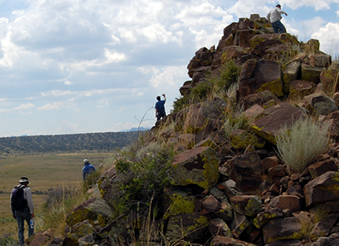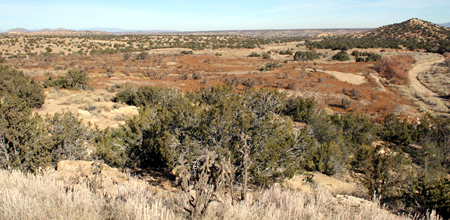
El Crestón
Galisteo Basin Sites
- Lamy Jct
- Lower Arroyo Hondo Pueblo
- El Camino Real
- Chamisa Locita
- El Crestón
- Espinoso Ridge Pueblo
- La Cienega Pueblo (LA 3)
- La Cienega Pithouse Village
- La Cieneguilla Pueblo (LA 16)
- La Cieneguilla Petroglyphs
- Manzanares Pueblo
- Paa-ko
- Petroglyph Hill
- Pueblo Blanco
- Pueblo Colorado
- Pueblo Galisteo
- Pueblo Largo
- Pueblo San Cristóbal
- Pueblo San Lazaro
- Pueblo Shé
- Rote Chert Quarry
- San José de Las Huertas
- Upper Arroyo Hondo Pueblo
- Pueblo San Marcos
The Crestón is a 7.24 km (4.5 mile) long geologic feature that extends westward from near New Mexico State Route 41 to very near Pueblo Blanco.
It is a basaltic dike that consists of three long ridges and one short ridge separated from each other by narrow gaps. The ridge itself rises 50 to 70 m above the basin floor. The western end is very near Pueblo Blanco, and there has apparently been some difficulty in delineating sites in the vicinity. In-depth research has been performed by the Archaeological Society of New Mexico’s Rock Art Field School. The site is also referred to as “Comanche Gap”; the name probably derives from Comanche raiding parties passing through the eastern Pueblo area in the mid-18th century
.png)
There are hundreds of images on the hard, dark basalt of the Creston. The rock and the pecking technique created durable and highly visible figures. Subjects include animal figures, shields, and spiritual figures.
The ASNM recording resulting in identification of 59
proveniences (each provenience composed of a stretch roughly 100 m long) within
which all human-made marks were documented as units referred to as loci or
panels. Almost all the rock art and the majority of the graffiti is on
southeast to southwest-facing surfaces on the south side of the dike. Most
images are stylistically and iconographically consistent with Rio Grande
Classic or Pueblo IV period, dating to about the 1300s to the early or
mid-1500s. Of all the human-made marks on the dike, 4,235 were thought to be
prehistoric. The nearest large pueblos, the Tano-speaking settlements of Pueblos
Blanco, She, and Colorado, were all occupied during this time. There are few Puebloan
rock art elements that appear to date to after the abandonment of those pueblos
in the mid-16th century. Several hundred elemen ts found dated to the
19th and early 20th century are Hispanic and Anglo in
origin and include initials, names, and dates. A total of 364 images, or
roughly 7.4%, were judged to be historic (50 years old and older).
ts found dated to the
19th and early 20th century are Hispanic and Anglo in
origin and include initials, names, and dates. A total of 364 images, or
roughly 7.4%, were judged to be historic (50 years old and older).
Piñon and juniper are present on the basin floor and the surrounding sandstone highlands, and in some portions steep slopes and crest of the dike itself. The levels and proportions of vegetation species reflect long use of the area for grazing—much of the flat land on either side of the dike is overgrazed and relatively bare. Fauna in the area include coyotes, cottontails, blacktailed jackrabbits, kangaroo and wood rats, ravens, golden eagles, various hawks, and a variety of smaller songbirds.

© New Mexico Office of Archaeological Studies, a division of the New Mexico Department of Cultural Affairs.
The Center for New Mexico Archaeology
7 Old Cochiti Road
Santa Fe, NM 87507
505-476-4404
Fax: 505-476-4448

